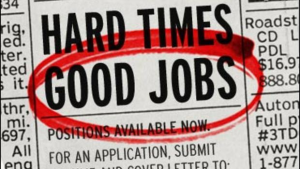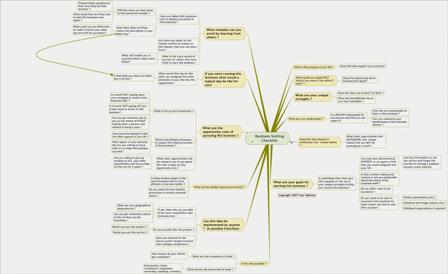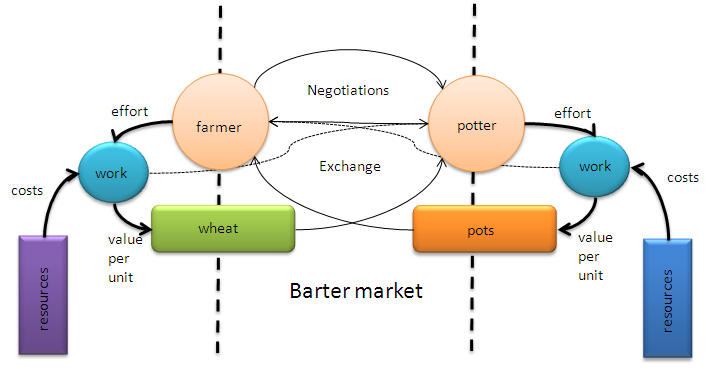The real unemployment rate is 22%.1 John Williams predicted a climb to 35% in light of the many negative converging factors of this artificial economic crisis we’re in.
A job lost in this economy is hard to replace. We may attempt to do what we love and hope the money will follow. However, less division of labor means less job choice. With one out of three workers unemployed it may come down to to doing what we must so that groceries will follow.
If you have a job hold onto it by:
- Becoming an invaluable employee with a superior attitude.
- Volunteering for extra work and showing great interest in what’s profitable for the business.
- Helping your company cut costs and waste.
- Contributing to your companies goal of bringing in revenue or new customers.
- Being a source of income, not expense, to the company your work for.
If you lost a job, recently, can you work part-time for your previous employer or hire yourself out in the same field?
If not, it’s back to the drawing board of . . .
Matching Abilities to Market Opportunities
In good times we may have the luxury of matching our most fulfilling abilities with a market opportunity. With less opportunities we have to either create our own market in line with our purpose (Optimal, but not easy) or match one of our less fulfilling abilities to a remaining opportunity. Either way, it’s helpful to have a clear view of what opportunities still exist.
The purpose of this article is to keep a running list of jobs and opportunities that exist even when the economy goes south. Such a list is useful to both entrepreneurs and job seekers, alike. Obviously, the more self-knowledge you have about the complete range of your strengths, weaknesses, values, goals and purpose the better chance you have at optimizing the work you do in any environment. However, a comprehensive list of jobs, known to be available in hard times, makes it much easier to zero-in on a best fit. My hope for this list of Jobs is that it:
- Puts a wide range of opportunities in front of you all at once.
- Jars your mind into creating a clear picture of what always needs to get done
- Points out an opportunity you might have missed or never thought of.
- Causes you to think of something, not on the list, that you wouldn’t have thought of otherwise (Please e-mail me your suggestions).
- Enables you to optimize a match between your abilities and market opportunities rather than taking the first thing that comes along.
- Enables a jump to higher state, closer to your individual purpose, even during these hard times.
As a list maker I know the value of a complete list. Although overwhelming, at first, its true value is the specific insight they give. You’ll care about only two to five items on this list. But, you’ve got to sift through a mountain of dirt to get to a gem. And, your dirt is someone else’s gem. The goal is to do what needs to be done that nobody else can, or is willing, to do.
Range of Strengths
People have a range of strengths and talents and are very adaptable. Let’s say, for the sake of argument, that each person is capable of doing 100 different jobs for which they could get paid. Let’s also say that each of those 100 jobs were listed out and prioritized such that job 100 was least preferred and job one was most preferred. It would be a very fortunate person working only on jobs 1 through 5. In hard times, however, one may need to flexible and willing to do any of those 100 jobs depending on what opportunities exist.
Of all the things you can do, for which there are opportunities available, pick the ones you could do, with relative ease, better than 80% of the people. It may sound cold, but, if you can’t perform in the top 20% then you’re a general worker and more likely to be expendable as companies cut back.
Consider More Than One
The ideal work for you may be doing two or three of these jobs on a part-time basis and getting your own small business started as a long term project. There may not be full-time work for your top choice and businesses seek temporary help during hard times. Even if you can find steady work in your top choices it’s always wise to hedge risk through multiple sources if income.
The Ways of Hard Times
In hard times, people and businesses tend to:
- Fix, not replace, existing equipment.
- Expand sources of revenue for their business.
- Cut the number of paid work hours in the week (Furlough days).
- Ask employees to take pay cuts.
- Focus on cutting costs to the bone.
- Take better care of what they have.
- Focus on essential needs rather than desires.
- Seek entertainment or psychological relief from endless worries.
- Seek temporary help rather than full-time employees.
- Keep work in-house rather than outsource.
Dirty, Difficult, Dangerous (And in Demand)
There’s always work available for people willing to perform dirty, difficult or dangerous jobs. Since these terms are subjective only you can decide what they mean. Ideally, something others consider difficult is not difficult for you. Same goes for dirty or dangerous. To provide good samples I’ve included all the jobs from the Discovery Channel’s Dirty Jobs and denoted them with an asterisk.
Work is Everything You Must Do
Anything you must do to provide for the needs of your family is work. When performing this work you are employed whether you’re paid or not.
What we really need is to provide food, clothes, shelter and security for our families. We need the real things listed in Checklist for Hard Times. A job is an indirect means of providing these real things for our family. Anything you can do to provide them, directly, decreases your dependency on working for someone else.
- Barter with your excess instead of spending new money you have to work for.
- Cut overhead.
- Swap services and expertise with trusted friends.
- Store new money into real things instead of disintegrating fiat money.
All the simple things suggested in Your Optimal Bailout Plan and Depression Proof your money can be done whether you have a formal job or not. In fact, being formally unemployed may create a time and space to work on eliminating the need for a conventional job, altogether!
After all, who cares if your labeled ‘unemployed’ if you’re meeting all the needs of your family?!
Jobs For Hard Times
Anyone who has seen a balance sheet for a business knows there’s a small number of income sources and a large number of expenses. Each job, below, represents a possible source of income.
(Note: This is a running list. Please e-mail your ideas for additions and subtractions. I’ll post them here at YourOptimal so others may benefit.)
Accounting – Cut costs and avoid taxes
Accupuncturist
Agricultural Equip. Parts & Personnel
Airport Maintenance*
Alligator Farmer*
Alpaca Farmer*
Alternative Communications Systems
Animal Barber*
Appliance Repair
Auto Mechanic
Auto Parts & Personnel
Bakery
Bankruptcy Consultant
Bar – Tender, Keep, Supplier
Barge Demolition*
Barter Exchanges – Clearing Houses For Goods.
Bat Guano Collector*
Battery Recharging Services
Bee Exterminator*
Beekeeper
Bicycle Shop & Repair
Big Animal Vet*
Billboard Installer*
Bio-Diesel Recovery*
Blacksmith
Blogger or Freelance Writer in a Unique Niche
Bodywork – Car, Truck
Bologna Maker*
Bridge Painter*
Buoy Cleaner*
Bus Driver
Camel Rancher*
Candle Maker
Cardboard Packaging
Career Counselor
Carpenter – Temp shelters, House Repair, Security
Casino Food Recycler*
Catfish Noodler*
Cattle Rancher*
Cave Cleanup*
Cave Digger – Excavate Wine Caverns In Napa Valley*
Cell Tower Maintenance
Charcoal Maker*
Cheese Maker*
Chick Sexer*
Chicken Raising/Breeding
Child Daycare
Chimney Sweeper*
Chiropractor
City Hall Jobs
Coal Miner*
Coffee Shop – Barista, Proprietor
Communications Equipment Repair
Community Colleges – Career (Re)Training
Complementary alternative medicine
Computer Rental & Repair
Concrete Spreader*
Cook/Chef
Cooper – Barrel maker
Copywriters for Ad Copy
Cosmetologist – Basics That Boost Spirits
County Clerk Office
Crab Fisherman*
Crawfisher*
Custodian for Empty Buildings
Dairy Farmer*
Debt Advisor
Debt Collection
Demolition Worker*
Dentistry/Oral Surgery
Diaper Cleaner*
Direct Marketing
Disaster Cleanup*
Doctor
Doctor’s Offices
Drivers – Bus, Van, Truck, Dumptruck
Drugstores
Educational Services – Trade Schools, Retraining
Egg Farm*
Electrician (Power Generation & Distribution, Communication)
Electronic Waste Recycling*
Engine Repair / Mechanic / Machinist
Engineer (Mechanical, Electrical, Civil, Metallurgical/Materials)
Entertainment And Diversions – DVD Rental
Exterminator*
Farm Equipment Repairman
Fill-In Worker For No Shows
Firearms Instructor
Fish Gutter*
Fix Things
Food Recycler*
Foreclosure Services
Fruit
Fuel Tank Cleaner*
Garbage Collector*
Garbage Pit Technician – Convert Trash Into Electricity*
Gardener
Gasoline Service Stations
General Stores – Mom And Pop
Generators Ac & Dc (Supply, Repair, Maint, Installer)
Glass Maker*
Goat Farmer*
Golf Ball Diver*
Goose Down Plucker*
Gourd Maker*
Green Algae Grower*
Grocery Store
Groundskeeper for Large Estates
Guns And Ammo Supply
Gunsmith
Handyman (Carpenter, Plumber, Roofer, Mr. Fix it)
Harvest Field Workers
Harvest Hops*
Harvest Walnuts*
Healthcare Services (Admin, Therapy)
Heating Oil Tank Removal*
Herb Grower/Supplier (Medicinal)
High-Rise Window Washer*
Home Retrofitting For Senior Access
Home Security And Locksmithing
Homeschooling Teachers
Honey Harvester*
Hoof Cleaner*
Horse Breeder*
Hot Tar Roofer*
Hunter/Trapper
Hydroelectric Dam Maintenance*
Import / Export – Anything & Everything
Infrastructure Repair – Communications, Utilities, Roads
Installing Insulation
Internet Café
Junkyard Dealers
Language Translator
Lawn & Garden Parts & Personnel
Leatherwork / Tanner
Leech Trapper*
Liquor Stores
Locksmith
Maggot Farmer*
Marketers – Drum Up Business
Massage Therapist
Mattress Recycler*
Mechanic – Aircraft
Mechanic – Automobile
Mechanic – Keeping Stuff Running
Midwife
Mortician
Mosquito Control*
Mule Logger*
Museum Conservator
Mushroom Farmer*
Nurse
Nursery Worker
Off-grid Power Supply – Sell, Install, Repair, Consult
Oil Drilling*
Optometrists
Ostrich Farmer*
Oyster Harvester*
ParaLegal Services
Paramedics/EMT
Parent – Stay at Home, Homeschooling
Parts & Personnel for EVERYTHING
Pawn Shops
Pest Control*
Pet Groomer*
Pharmacist
Physical Therapy
Physician (General Practice, Surgeon, Ob-Gyn)
Physician Assistants
Pig Farmer*
Plumber
Plumbing Parts & Personnel
Potato Farmer*
Power Supplies – Fix, Repair, Maint
Precious Metal Dealer
Psychological Counseling
Recharge Batteries
Reindeer Farmer*
Reloading
Repair – Home, Car, Commercial, And Industrial Repair
Repair Shops
Repairs And Maintenance Of All Kinds
Repairing Utilities
Repossession Services
Roadkill Recovery*
Rock Quarry*
RV Maint & Repair
Salespeople
Salt Miner*
Salt Supplier
Schoolbus Driver
Scrap Metal Recycling*
Second Hand Stores
Security Consultant
Security Guard
Security Improvements – Building Barriers, Install Cameras
Seed Supplier
Senior Care Management
Septic Tank Technician*
Sewer Inspector*
Shark Catcher*
Sheep Castrator*
Shoe Repair
Shrimper*
Skull Cleaner*
Sludge Recycler*
Snow Plowing
Soldier – If you really must
Spray Insulation*
Steam Ship Cleaner*
Steel Mill Worker & Recovery*
Stonemason/Bricklayer
Storage Unit Cleanout
Storm Drain Metal Recovery*
Street Vendors – Meat, Corn, Fruit, Ice Cream, Tacos, Candy
Sunken Logs Recovery*
Survival Supplies Dealer
Swap Meets – Setup, Organizers
Tailoring/Alterations
Teacher/Tutor
Telephone Repair
Temporary Workers (Biggest Category And Opportunity Here)
Termite Controller*
Tire Recycler*
Tofu Maker*
Toilet Crusher And Recycler*
Towtruck Driver
Trade Schools
Truck Farming And Large Scale Vegetable Gardening
Turkey Farmer*
Unloading Railroad Cars
Utilities
Van Drivers
Vegetable Gardening
Vellum Maker – Turns Animal Hides In To Paper*
Veterinarian
Vice: Sex, Moonshine, Drugs, Gambling
Waste Water Sewage Plant*
Welder
Well Digger*
Wind Farm Technician*
Windshield Glass Repair
Wine Maker*
Wood Stoves
Worm Rancher*
*These were featured jobs on the the Discovery Channel show “Dirty Jobs“.
1It’s 9/2/2014






